by Eric Meier
When attempting to identify a wood sample, it’s important to keep in mind the limitations and obstacles that are present in our task. Before starting, please have a look at The Truth Behind Wood Identification to approach the task in a proper mindset; I consider the linked article to be required reading for all those visiting my site with the intent of identifying wood.
1. Confirm it is actually solid wood.
Before proceeding too much farther into the remaining steps, it’s first necessary to confirm that the material in question is actually a solid piece of wood, and not a man-made composite or piece of plastic made to imitate wood.
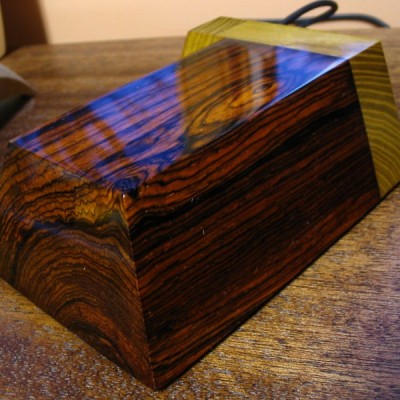
Can you see the end-grain?
Manufactured wood such as MDF, OSB, and particleboard all have a distinct look that is—in nearly all cases—easily distinguishable from the endgrain of real wood. Look for growth rings—formed by the yearly growth of a tree—which will be a dead-giveaway that the wood sample in question is a solid, genuine chunk of wood taken from a tree.
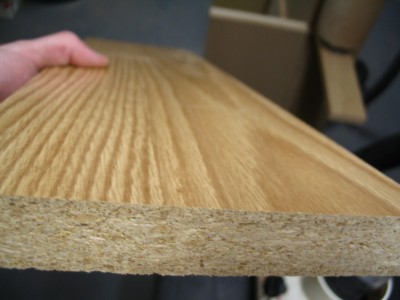
Is it veneered?
If you see a large panel that has a repeating grain pattern, it may be a veneer. In such cases, a very thin layer of real wood is peeled from a tree and attached to a substrate; sometimes the veneer can be one continuous repeating piece because it is rotary-sliced to shave off the veneer layer as the tree trunk is spun by machines. Assuming it is a real wood veneer with a distinct grain and texture—and not merely a piece of printed plastic—you may still be able to identify the outer veneer wood in question, but you should still realize that is it only a veneer and not a solid piece of wood.
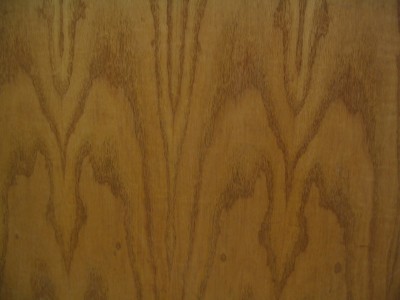
Is it painted or printed to look like wood?
Many times, especially on medium to large-sized flat panels for furniture, a piece of particleboard or MDF is either laminated with a piece of wood-colored plastic, or simply painted to look like wood grain. Many of today’s interior hardwood flooring planks are good examples of these pseudo-wood products: they are essentially a man-made material made of sawdust, glues, resins, and durable plastics.
2. Look at the color.
Some questions to immediately ask yourself:
Is the color of the wood natural, or is it stained?
If there is even a chance that the color isn’t natural, the odds are increased that the entire effort of identifying the wood will be in vain.
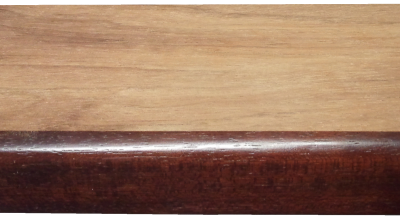
Is it weathered or have a patina?
Many woods, when left outside in the elements, tend to turn a bland gray color. Also, even interior wood also takes on a patina as it ages: some woods get darker, or redder, and some even get lighter or lose their color; but for the most part, wood tends to darken with age.
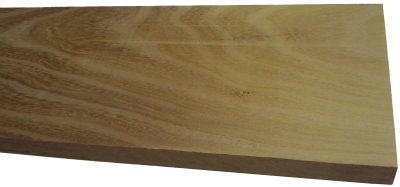
Is it possible to sand or plane the board to see the natural raw color of the wood?
The most predictable baseline to use when identifying wood is in a freshly sanded state. This eliminates the chances of a stain or natural aging skewing the color diagnosis of the wood.
3. Observe the wood grain.
If the wood is unfinished, then look at the texture of the grain. Ask yourself these questions:
Does the wood have an open, porous texture?
Most softwoods will be almost perfectly smooth with no grain indentations, while many common hardwoods have an open pore structure, such as oak or mahogany; though there are some hardwoods that are also smooth to the touch, such as maple.
Can you tell if the wood is quartersawn or plainsawn?
By observing the grain patterns, many times you can tell how the board was cut from the tree. Some wood species have dramatically different grain patterns from plainsawn to quartersawn surfaces. For instance, on their quartersawn surfaces, lacewood has large lace patterns, oak has flecks, and maple has the characteristic “butcher block” appearance.
Is there any figure or unusual characteristics, such as sapwood, curly or wild grain, burl/knots, etc.?
Some species of wood have figure that is much more common than in other species: for example, curly figure is fairly common in soft maple, and the curls are usually well-pronounced and close together. Yet when birch or cherry has a curly grain, it is more often much less pronounced, and the curls are spaced farther apart.
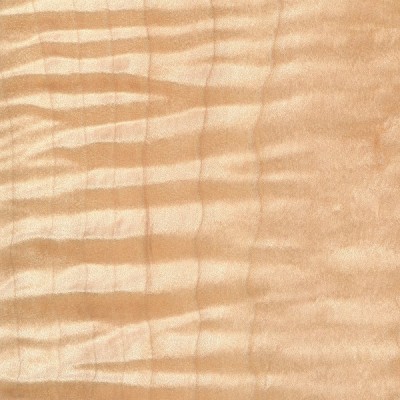
4. Consider the weight and hardness of the wood.
If it’s possible, pick the piece of wood up and get a sense of its weight, and compare it to other known wood species. Try gouging the edge with your fingernail to get a sense of its hardness. If you have a scale, you can take measurements of the length, width, and thickness of the wood, and combine them to find the density of the wood. This can be helpful to compare to other density readings found in the database. When examining the wood in question, compare it to other known wood species, and ask yourself these questions:
Is the wood dry?
Wood from freshly felled trees, or wood that has been stored in an extremely humid environment will have very high moisture contents. In some freshly sawn pieces, moisture could account for over half of the wood’s total weight! Likewise, wood that has been stored in extremely dry conditions of less than 25% relative humidity will most likely feel lighter than average.
How does the wood’s weight compare to other species?
Taking into account the size of the board, how does its weight compare to other benchmark woods? Is it heavier than oak? Is it lighter than pine? Look at the weight numbers for a few wood species that are close to yours, and get a ballpark estimate of its weight.
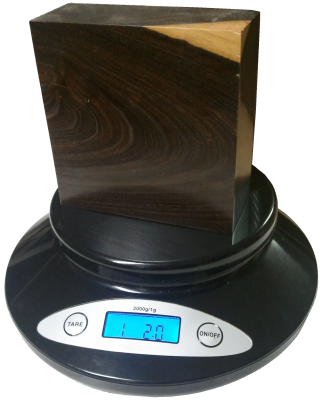
How hard is the wood?
Obviously softwoods will tend to be softer than hardwoods, but try to get a sense of how it compares to other known woods. Density and hardness are closely related, so if the wood is heavy, it will most likely be hard too. If the wood is a part of a finished item that you can’t adequately weigh, you might be able to test the hardness by gouging it in an inconspicuous area. Also, if it is used in a piece of furniture, such as a tabletop, a general idea of its hardness can be assessed by the number and depth of the gouges/dings in the piece given its age and use. A tabletop made of pine will have much deeper dents than a tabletop made of Oak. Additionally, you can always try the “fingernail test” as a rough hardness indicator: find a crisp edge of the wood, and with your fingernail try to push in as hard as you can and see if you’re able to make a dent in the wood.
5. Consider its history.
Many times we forget common sense and logic when attempting to identify wood. If you’ve got a piece of Amish furniture from Pennsylvania, chances are more likely that the wood will be made of something like black walnut or cherry, and not African wenge or jatoba. You might call it “wood profiling,” but sometimes it can pay to be a little prejudiced when it comes to wood identification. Some common-sense questions to ask yourself when trying to identify a piece of wood:
Where did it come from?
Knowing as much as you can about the source of the wood—even the smallest details—can be helpful. If the wood came from a wood pile or a lumber mill where all the pieces were from trees processed locally, then the potential species are immediately limited. If the wood came from a builder of antique furniture, or a boat-builder, or a trim carpenter: each of these occupations will tend to use certain species of woods much more often than others, making a logical guess much simpler.
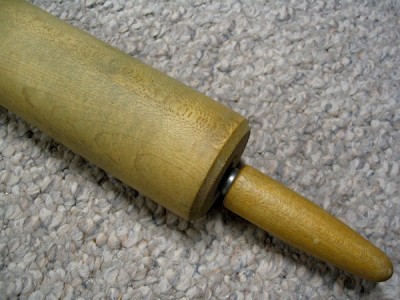
How old is it?
As with the wood’s source, its age will also help in identification purposes. Not only will it help to determine if the wood should have developed a natural patina, but it will also suggest certain species which were more prevalent at different times in history. For instance, many acoustic guitars made before the 1990s have featured Brazilian rosewood backs/sides, yet due to CITES restrictions placed upon that species, East Indian rosewood became a much more common species on newer guitars. (And this is a continuing shift as newer replacements are sought for rosewoods altogether.)
How large is the piece of wood?
Some species of trees are typically very small—some are even considered shrubs—while others get quite large. For instance, if you see a large panel or section of wood that’s entirely black, chances are it’s either painted, dyed, or stained: Gaboon ebony and related species are typically very small and very expensive.
What is the wood’s intended use?
Simply knowing what the wood was intended for—when considered in conjunction with where it came from and how old it is—can give you many clues to help identify it. In some applications, certain wood species are used much more frequently than others, so that you can make an educated guess as to the species of the wood based upon the application where it was used. For instance, in the United States: many older houses with solid hardwood floors have commonly used either red oak or hard maple; many antique furniture pieces have featured quartersawn white oak; many violins have spruce tops; many closet items used aromatic red cedar, and so forth. While it’s not a 100% guarantee, “profiling” the wood in question will help reduce the number of possible suspects, and aid in deducing the correct species.
6. Find the X-Factor.
Sometimes, after all the normal characteristics of a sample have been considered, the identity of the wood in question is still not apparent. In these instances—particularly in situations where a sample has been narrowed down to only a few possible remaining choices—it’s sometimes helpful to bring in specialized tests and other narrower means of identification.
The following techniques and recommendations don’t necessarily have a wide application in initially sorting out wood species and eliminating large swaths of wood species, but will most likely be of use only as a final step in special identification circumstances.
Odor
Believe it or not, freshly machined wood can have a very identifiable scent. When your eyes and hands can’t quite get a definitive answer, sometimes your nose can. Assuming there is no stain, finish, or preservative on or in the wood, quickly sand, saw, or otherwise machine a section of the wood in question, and take a whiff of the aroma.
Although new scents can be very difficult to express in words, many times the scent of an unknown wood may be similar to other known scents. For instance, rosewoods (Dalbergia spp.) are so named for their characteristic odor that is reminiscent of roses. Although difficult to directly communicate, with enough firsthand experience scents can become a memorable and powerful means of wood identification.
Fluorescence
While certain woods can appear basically identical to one another under normal lighting conditions, when exposed to certain wavelengths—such as those found in blacklights—the wood will absorb and emit light in a different (visible) wavelength. This phenomenon is known as fluorescence, and certain woods can be distinguished by the presence or absence of their fluorescent qualities. See the article Fluorescence: A Secret Weapon in Wood Identification for more information.
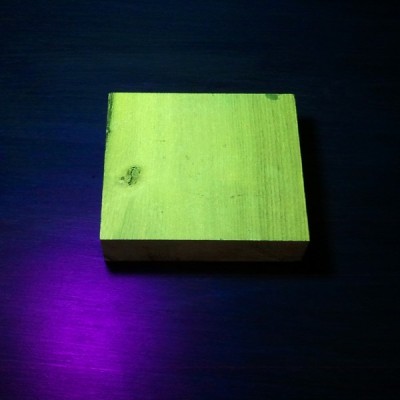
Chemical Testing
There are only a small number of chemical tests regularly used on wood, most of which are very specialized and were developed to help distinguish easily confused species with one another. They work by detecting differences in the composition of heartwood extractives. A chemical substance (called a reagent) is usually dissolved in water and applied to the wood surface: the surface is then observed for any type of chemical reaction (and accompanying color change) that may occur. Two of the most useful are the tests that are meant to separate Red and White Oak, and Red and Hard Maple.
Heartwood Extractives Leachability
Sometimes a wood species will have heartwood extractives that will be readily leachable in water and capable of conspicuously tinting a solution of water a specific color. For instance, the heartwood extractives contained in osage orange (Maclura pomifera) contain a yellowish-brown dye that is soluble in water. (This can sometimes be observed anecdotally when the wood is glued with a water-based adhesive: the glue’s squeeze-out is an unusually vibrant yellow.)
In a simple water extract color test, wood shavings are mixed with water in a vial, test tube, or other suitably small container, and the color of the water is observed after a few minutes. If the heartwood extractives are leachable by water, then a corresponding color change should quickly occur.
In addition to osage orange (Maclura pomifera), merbau (Intsia spp.), and rengas (Gluta spp. and Melanorrhoea spp.) are also noted for their readily leachable heartwood extractives. Because this property is quite uncommon, it can serve to quickly differentiate these woods from other lookalikes.
7. Look at the endgrain.
Perhaps no other technique for accurate identification of wood is as helpful and conclusive as the magnified examination of the endgrain. Frequently, it brings the identification process from a mostly intuitive, unscientific process into a predictable, repeatable, and reliable procedure.
Looking at the endgrain with a magnifier shouldn’t be a mystifying or esoteric art. In many cases, it’s nearly as simple as examining small newsprint under a magnifying glass. There are three components necessary to reap the full benefits contained in the endgrain:
I. A prepared surface.
When working with wood in most capacities, it becomes quickly apparent that endgrain surfaces are not nearly as cooperative or as easily worked as face grain surfaces. However, in this case, it is absolutely critical that a clear and refined endgrain surface is obtained.
For a quick glance of a softwood sample, a very sharp knife or razor blade can be used to take a fresh slice from the endgrain. However, in many denser species, especially in tropical hardwoods, one of the best ways to obtain a clear endgrain view is through diligent sanding. It’s usually best to begin with a relatively smooth saw cut (as from a fine-toothed miter saw blade) and proceed through the grits, starting at around 100, and working up to at least 220 or 320 grit, preferably higher for the cleanest view.
II. The right magnifier.
It need not be expensive, but whatever tool is used to view the endgrain should have adequate magnifying power. In most instances, 10x magnification is ideal, however, anything within the range of 8 to 15x magnification should be suitable for endgrain viewing. (Standard magnifying glasses are typically in the range of 2 to 4x magnification.)
These stronger magnifiers, sometimes called loupes, usually have a smaller viewing area than standard magnifying glasses. Fancier models—with built in lights, or larger viewing surfaces—are available at a premium; but the most basic models are usually only a few dollars.
III. A trained eye.
The third element that constitutes a proper endgrain examination is simply knowing what to look for. In analyzing the patterns, colors, shapes, and spacing of the various anatomical features, there is a veritable storehouse of information within the endgrain—all waiting to be unlocked. Yet, if these elements have not been pointed out and learned, the array of features will simply seem like an unintelligible jumble. The discipline of recognizing anatomical endgrain features is not easily summed up in a few sentences or even a few paragraphs, but it is nonetheless critical to the identification process. To this end, an in-depth look should be given to the various categories, divisions, and elements that constitute endgrain wood identification on the macroscopic level. (In this regard, macroscopic denotes what can be seen with a low-powered, 10x hand lens—without the aid of a microscope—rather than simply what can be seen with the naked eye.) Because the anatomy between softwoods and hardwoods is so divergent, each will be considered and examined separately:Still stumped?
If you have a mysterious piece of wood that you’d like identified, you’ve got a few options for next steps:USDA’s Forest Products Laboratory
You can mail your physical wood samples to the Center for Wood Anatomy Research.
Pros:
- Free
- Professional wood identification
Cons:
- Only available to US citizens
- Slow turnaround times (up to a month or more)
- Limited to three IDs per year
See their Wood ID Factsheet for more info.
Alden Identification Service
You can mail your physical wood samples (even small sections taken from antiques) to Alden Identification Service.
Pros:
- Professional wood identification
- Faster turnaround times (ranging from a few days to a week or two)
Cons:
- Paid service
See their ordering page for more info. (Note that Harry Alden has written several books while at USDA, including both Hardwoods and Softwoods of North America.)
Ask for help online
If the wood ID is merely a curiosity, or non-critical, you can post pictures of the wood in question.
Pros:
- Free
- No need to send physical samples
Cons:
- Greatly limited by the quality of the pictures provided
- Extra work usually required to get adequate clarity in photos
See article of Common US Hardwoods to help find the most commonly used woods.
Get the hard copy
 If you’re interested in getting all that makes The Wood Database unique distilled into a single, real-world resource, there’s the book that’s based on the website—the Amazon.com best-seller, WOOD! Identifying and Using Hundreds of Woods Worldwide. It contains many of the most popular articles found on this website, as well as hundreds of wood profiles—laid out with the same clarity and convenience of the website—packaged in a shop-friendly hardcover book.
If you’re interested in getting all that makes The Wood Database unique distilled into a single, real-world resource, there’s the book that’s based on the website—the Amazon.com best-seller, WOOD! Identifying and Using Hundreds of Woods Worldwide. It contains many of the most popular articles found on this website, as well as hundreds of wood profiles—laid out with the same clarity and convenience of the website—packaged in a shop-friendly hardcover book. 





Why I will no longer be replying to every wood ID request I’ve replied to literally thousands of wood ID requests on this site over the past 13+ years, but as the site’s popularity has grown, so has the time demands for ID on a daily basis. (Contrary to what some may seem to think, I am not some all-knowing wood wizard that can instantly ID your wood. It can actually take me a long time to sift through a lot of different resources.) Over the past few years, my backlog of pending wood species to be added to the… Read more »
Hi we make knives in Australia, our overseas supplier from China has given us some handles that they say are from USA and called it Destert Iron wood, can you look at the pictures and give us your recomendations on what you think it is? I know this may be difficult but any help is appriciated
Thanks
I see no reason to doubt that it is desert ironwood. https://www.wood-database.com/desert-ironwood/
Hello, We just purchased a house with solid wood cabinets in the kitchen and dining room that have most people stumped. Two cabinet makers have said they are spalted hickory while another cypress. I love the cabinets and want to keep them and don’t want to paint them, just cleaned up and sealed. I have provided a photo of a cabinet face, a close up of the cabinet and a set in the dining room…with my pup. They are not super heavy…rather medium in weight. Would love to know what we have and if I’m correct in keeping the cabinets…many… Read more »
Well, they are a ring porous hardwood, so they’re definitely not cypress. I think that most of the color is coming from a stain, not spalting. It appears there’s dark-colored pigment lodged in the pores from a stain, while spalting wouldn’t necessarily follow the growth ring lines as this coloration does.
Hickory is not a bad guess. But if they are as light as you say they are, I would be more inclined to say they are ash.
Just wondering what kind of wood this is in my apartment. Hoping to get furniture to match or at least complement.
Looks like red oak.
Hi I have this table that is real wood but each joined piece looks like they are from different wood species. The wood is easily dented. Also the table top is a natural wood colour but the sides of the table have been stained or dyed making it look like a red cherry wood. Can you please help advise what type of wood this table is made of. also when I wiped where the grooves were (you can see how red the flat panels on the side of the table are vs the table top ) with disinfectant, a bright… Read more »
It looks like the table is solid wood, though it’s pretty old and weathered. There’s nothing wrong with that per se, it may just need to be refinished.
Unfortunately on the ID front, there’s a two-fold problem of being stained (so as to not see the natural grain and color of the wood clearly) and also being from Australia (so the set of possible species is completely different than what I’m used to choosing from in North America).
Thanks Eric. Would you know why a bright red stain is coming off when I wipe the side panels with disinfectant. This occurred on all sides of the table. the red stain was easily wiped off from the entire first wooden groove (the section below after the red stripey panel) and the stain could be easily wiped off around on four sides of the table. The rest of the panels on each side do not having this red stain rub off. The wood still remains a dark red though after I wiped this off, as some stain has successfully soaked… Read more »
The table looks heavily worn and weathered, with many part having the outer layer of finish missing completely. Stain itself has never meant to be durable on its own, it is meant to simply color the wood and then be sealed in and protected by a top layer of finish.
A lot will depend on your preference and tolerance for imperfection. I think the most ideal thing would be to completely strip and refinish the entire table, but this would be a lot of time and effort.
I bought this stool and have always wondered what types of wood were used. Please see pictures
Found this treasure of a lamp at a thrift store. After stripping the stain, here’s what I’m left with. The red coloring is quite prevalent. Would love to know the species. Thanks
Can’t say for sure, but it reminds me of Pterocarpus tree species, like muninga or narra.
Oh interesting – thanks for your time and feedback.
I’m trying to identify the wood used in our arbor. I’m not sure why it has all the lines in it, The wood was stained so it’s dark, it was supposed to be cedar.
Thanks
Can anyone tell what specie of wood are this cabinets?
I can’t tell for sure from the pic, but it’s a ring porous hardwood. Oak would be the likeliest candidate, but there are a number of other possibilities.
But I will say, based on the construction, they are not rail-and-stile type cabinet doors (which would be preferred for stability/quality), but appear to just be made of plywood, which would generally be of lower quality.
Thank you so much!
Wondering what kind of wood my floor is.
my house was built in the 40’s. It has a weird smell as I am sanding it down.
please help me identify
Probably oak? Hard to tell from that distance.
I bought this China cabinet to paint the exterior black and I wanted to strip and stain the shelves a light stain. I have stripped and sanded but now I’m worried about staining because I have read certain woods will only darken such as mahogany. Any ideas what I have hear before I try and satin and get disappointed if it turns red again.
Hello, I bought an old coffee table set that had marble slabs on-top, I am refinishing the wood bases and would be curious to know what kind of wood I am working on. Thank you
Here’s a better photo
Wondering what kind of wood this is. It came from overseas as a pallet. It is very heavy. When 5 pieces are joined together It takes 2 people to pick it up. Material on it was from Thailand.
Hello, could anyone help me identify what wood this is please? We recently purchased the property and not sure what it is, house was built in 2004 in UK. Any help would be much appreciated.
Here’s another photo
Looks like oak
Thrift store find. This is the back of a mirror. The front is stain that has been painted over. Will strip and refinish. Seems like a hardwood. Seems like a tight grain with no knots. Have you any idea based on the picture as to wood type ?
Looks like a hardwood, though I can’t tell ID since it appears to be stained a much darker color.
Hello,
Looking for help identifying the wood on my dining set. It is quite old and has been in the family for many years. I have attached pictures of the finished top side and also of the unfinished bottom. Thank you!
The grain on the top looks painted on, and I don’t believe it’s a real wood grain. The underside appears to be very darkly stained utility wood, possibly something like birch or poplar.
Hi, I would greatly appreciate any help identifying this wood. It was sold among a shipment of Leadwood but it just looks very different from all the other pieces I received. It has a very warm red brown, much redder and lighter than the other pieces of leadwood with a courser looking texture of larger black pores/ spots. (The second picture shows it next to a piece of Leadwood). It is equally hard and heavy though. The density of this specific piece is 1.26 g/cm3 or 78.66 lbs/ft3 The closest matches from your fantastic database seem to be Camelthorn or… Read more »
The piece still looks like leadwood to me. Perhaps its a newer piece that hasn’t aged as much, or was from a different lot than the other stuff you received?
You’re right, it could be easily from another lot/ differently aged since I bought it from a shop and not directly from a sawmill.
I was just very surprised by the difference in colour texture. And it’s also the first time for me to work with Leadwood or any other heavy African wood species, so I don’t have any personal frame of reference or idea what else it could have been.
Thanks a lot for your opinion and the great database, Eric!
hey! clearing out a storage unit – this table top is heavy but one person can lift it when upright (as shown in photo) The wood is sanded down/no varnish on bottom edge corners where table legs were attached. Don’t notice a distinct odor but that’s probably because it’s varnished. Really appreciate any help! Thanks :)
Hi Ariane, I am not an expert in recognising woods, but one thing you can see it is not a solid piece of wood, but veneered particleboard or plywood. In the third picture you see from three sides it has no endgrain. Beautiful table! I love this kind of veneered material, mostly used in vintage / mid century furniture.
Built in 2001
Looks like red oak. But it looks a bit off to me, and it may not be solid wood. You can see in the places where three boards in a row end at the same point, which is usually an indication that wider, engineered planks were used. If it were solid wood, the installer would never end two boards (much less three) all at the same length.
Did a knife class, and the instructor thinks this is canary wood, but is it?
I don’t think it’s canary. Do you have a closeup picture of the endgrain, finely sanded?
This is the only other photos I have unfortunately
Possibly zebrawood? Can’t tell too much without a clear, closeup picture of the endgrain.
It looks like it, thank you so much for your input!!
I purchased a home that looks to be built around 1900-1920’s. I’ve just sanded the floors and it appears I have two different type of wood here. Can you help me identify the two? I believe the bigger planks maybe pine. Not sure about the other.
Looks like oak and a softwood, possibly pine as you suspect.
Thank you!! Much appreciated!!
We bought a table from someone who was moving who acquired it with his house. Very heavy – mover estimated 200 lbs for 5’ round table – and dense, no odor with a rippled top. Ignore the glue – that was to repair a non matching chair! What is it?
Extending these solid wood interior doors. Not 100% on the type of wood.
Old cuttingboard I found in relatives house. I’m stumped on this wood. I was thinking it was White Ash but not sure.
The green and gray coloration reminds me of yellow poplar.
It looks just like some of the yellow poplar. There distinct color difference between the sapwood and heartwood is a clue as well.
Dear Wood-Database.com,
Could you please tell me what type of wood this is? Thanks!
Looks kinda like white oak but that’s just a guess. I’m not an expert by any means. But the wide grain pattern is similar to white oak.
Vintage or Antique Wooden Bowl. Heavy for its size. Can anyone help me identify the type of wood. Many thanks.
Can anyone tell me what type of slab this is?
Looks like a softwood species of some sort, so something like pine, fir, etc. Would need to clean up the endgrain and check for resin canals to tell more.
What type of wood is this? I think it’s cherry wood.
Great site here! I’m stumped with what type of wood this is (bad pun). First it’s from a Pier 1 TV tray table top, likely circa 1990’s. First thought it was bamboo but it has knots. I sanded finish down, it laughed at my 100 grit paper on power sander, though the paper was a bit worn…. It’s somewhat light but has a very, very hard surface. Yet it did absorb some teak oil stain, and teak oil sealer reasonably quickly. I also tested with Cetol as a finish. I’m repurposing as a cockpit table for my boat since it’s… Read more »
Looks like rubberwood to me.
Thank you
Hi there!
I just moved into my first house, and pulled up the carpet to reveal hardwood! I’m not sure what kind of wood it is, could anyone take a look? In the picture, I believe there’s two finishes, and in the middle the threshold might be the raw wood.
Thank you!
Looks like oak to me, with the stuff on the left having a natural finish and the stuff on the right being stained.
Thanks!
Not sure why someone had carpet over that. A little TLC and you’ve got a beautiful floor that will last forever.
yeah, we were happy to see it was in good shape! We’re going to sand it all down, and then do a natural finish more like the light color under the carpet.
Hi
Does anyone know what type of wood is my furniture please?
Thank you for your help
The frequent large knots points toward a softwood species like pine.
Planning to refinish this outdoor chair and would like to identify wood so I understand how to sand, stain, and seal it. The chair and ottoman are very light weight for size.
Looks like a softwood species. Since it is meant for outdoors, it may be a species of cedar.
Anyone know what this is? Found this slab and I am making a bench but would like to know what type of wood it is.
It looks closest to a species of oak in the white oak group to me, taken from a very old tree. The color seems strange though, almost as if it had been painted black and then stripped off, or had some other stain applied before.
Thank you for the information, I had already stained the slab and have since begun stripping it off. I didn’t like the color, so was hoping to find out what type of wood so that I could better anticipate what the stain would look like.
Hand rail found in basement. Freshly sanded. Maple maybe
Those extra wide dark areas of growth rings really point to a softwood. Possibly a species of pine.
I purchased a home and have no idea what type of flooring this is. I need to replace some spots. Any idea? It’s textured and feels like real wood, home built in around 1975. I’m not sure if it’s a laminate floor or small pieces of wood laid in this pattern.
Yes, it’s parquet flooring made of oak (with a fairly dark stain applied)
Purchased this lovely chair with the view of restoring it to reveal its full glory, any ideas of age and style would be helpful, thank you
Looks like a ring porous hardwood that’s been stained fairly dark. Possibly something like oak or ash. If you’re committed to the project, I think it’d be best to get down to the raw, unstained wood and restain (if that’s the look you’re after) to a uniform color and then apply a wear resistant finish like polyurethane. It looks like the finish and stain rubbed off the front of the chair from heavy use.
Thank you for the info Eric
Most appreciated
Joe
Completely agree. Sand it down and start fresh and stain it however you want. Has lots of potential.
I’m trying to identify the type of wood that this sample is made out of.
Can’t say for sure, but at the very least the grain looks mahogany-like.
Kinda looks like Padauk also. Can you tell us what the original color was? Somewhere on the sample piece, take some 80 grit sandpaper and sand it down to the raw material and then post a picture of what that looks like. I think it’s Padauk but can’t be sure.
Moving the kitchen island around and found that the previous owner didn’t have hardwood under it installed, but we are having a real hard time finding a match. Any thoughts???
I’m pretty sure that is Hickory. If not maybe Teak. Either way you have some fantastic flooring. Both are really great species. May get expensive finishing under the old island.
Google Hickory hardwood flooring and you’ll see what I mean. They look so similar.
I’m trying to identify the wood species on this antique desk or dining table.
quartersawn white oak
Thank you so much!
I purchased 2 candlestick holders both made in Thailand. Upon closer inspection, they’re made from different wood. Ant idea?
Hi, what does this wood grain look like? Trying to find a way to match it to repair the hole. Thank you!!
Looks like a diffuse porous tropical hardwood veneer that’s quartersawn. Not sure on a species, but I would just look for something that’s been quartersawn to get an even uniform grain and use a stain to match the color as best as possible.
Thank you!!!
I’m trying to identify the type of wood that this plaque is made out of. The country of origin is China. The age of the wood is between 80-110 years old (so it has likely darkened a bit). It has been stored, so identifying a distinctive odor was difficult (it smells like a box LOL). I would likely have to have been a wood native to China, but I suppose it could have been imported (likely between 1900-1920 or thereabouts).
A bigger picture might have helped. I asked someone else and they said maybe elm or cypress?
This one shows the back of the plaque. The small “dots” aren’t flaws in the wood, but rather small pegs where the craftsperson fastened the inlaid stone by pounding them through the back of the plaque. I apologize for not including these two photos with the original post.
Restoring an old Excelsior dome top trunk. Thought these were all oak but I need to splice in a break that I can’t identify, or duplicate, so far. Leftmost slat, next to the black iron. Any ideas?
Massive ceiling lamp. Probably some kind of fruit wood
Does anyone know what type of wood this door is
Can you recommend a laboratory in U.S. where a wood sample can be sent and analyzed? Can you give off hand based on the attached photo a ball park estimate which specie it is? I was told it is a very hardwood, the chainsaw’s chain used in slicing the tree toppled by a storm had to be replaced twice. The story behind it was the experienced chainsaw operator said he never came across any tree this hard in his decades of cutting trees
I can’t tell from the pics, and if it’s from Asia, I’m guessing it’s something very obscure and unknown to me. If you’re in the United States, I’d highly recommend the Forest Products Laboratory. https://www.fpl.fs.fed.us/research/centers/woodanatomy/wood_idfactsheet.php
Can you tell what wood this is? It was bought in mid 1980’s
Ring porous wood, possibly oak or ash.
This is the top of a sanded vintage ming style low table, origen unknown. I’ve tried as best I can to identify the wood, and am hovering around sheesham, but I thought I’d turn to those wiser and more knowledgeable than I.
Sheesh! I might be spoiled for life now. Love this! Never heard of it before but I google-lensed your picture and found more sheesham that looked very much like this, but I know nothing about it. And so far, there doesn’t appear to be anyone wiser and more knowledgeable than you. But how fun would it would be to use sheesham in a sheshed. :D Sheesham sheshed down by the seashore. Sheshore?
This is a very heavy piece. Any ideas on what type of wood this is?
Hello! I need to identify the wood in this executive desk! Thanks in advance! Definitely heavy enough that it normally takes 3 people to move it (or 2 really strong people) :)
Hi any idea what this wood is likely to be?
Looks like a softwood species such as pine or fir.
Hem fir